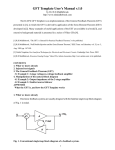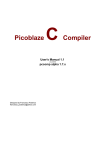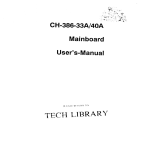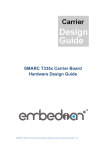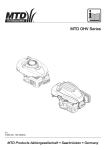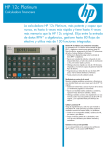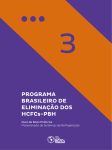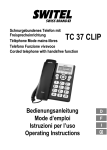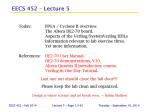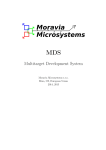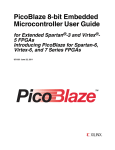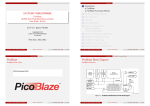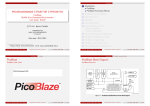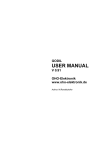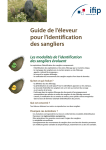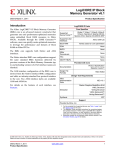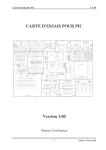Download Meeting 2 (05/07/09) - Electrical Engineering and Computer Science
Transcript
Meeting 2 Summer 2009 Doing DSP Workshop Today: ◮ Comments. ◮ Joining a lab section. ◮ Introduce FPGAs and VHDL. The modern computer hovers between the obsolescent and the nonexistent. — Sydney Brenner, attributed in Science, 5 January 1990. Doing DSP Workshop – Summer 2009 Meeting 2 – Page 1/64 Thursday – May 7, 2009 Workshop CD ◮ Workshop CD is rather full. Lots of relevant material. ◮ Most collections have an xxx.html (or the like) index file. ◮ A few don’t. ◮ Poke around. See what’s there. The collection is intended to save you time and give some focus. ◮ There are two DSP oriented text books included. Doing DSP Workshop – Summer 2009 Meeting 2 – Page 2/64 Thursday – May 7, 2009 Comments ◮ This is not a course. This is a workshop. Less structure, more opportunity to participate, more opportunity to pursue one’s own interests. ◮ Expect to have 6 lab exercises intended to familiarize you with the Workshop hardware. One per week for six weeks. ◮ Following these exercises you have the opportunity to focus on some aspect of DSP theory and/or implementation. ◮ The nominal end of the Workshop will be start of August, maybe mid August, well, whenever. ◮ Discussion sessions Tu and Th 1:00 PM to 2:30 PM. ◮ The first six weeks of discussions will focus on labs. Some DSP will be included. ◮ After six weeks will seek volunteers to research a topic and make a minimum 20 minute presentation to the Workshop. Doing DSP Workshop – Summer 2009 Meeting 2 – Page 3/64 Thursday – May 7, 2009 More comments ◮ We presently have about 28 Workshop members. ◮ The Workshop web page is at www.eecs.umich.edu/courses/doing_dsp/ ◮ A set of interesting questions can be found on the Workshop web site. We will discuss them starting one week from to day. This is NOT a homework assignment. However, you might want to treat it as such. ◮ There are two lab sections, one Tuesday and one Thursday. The max capacity is 18 students per section. This assumes lab partners. Feel free to use off time. ◮ The first lab session will be next Tuesday. ◮ I will be out of town Friday through Monday. Doing DSP Workshop – Summer 2009 Meeting 2 – Page 4/64 Thursday – May 7, 2009 First lab Introduces the Spartan-3 Starter Board and VHDL. ◮ Have to start somewhere, some time. ◮ Read (not study) the Spartan-3 Starter Kit Board User Guide. Can be found on the Workshop CD and on the Workshop handouts web page. ◮ Find a VHDL tutorial and read (not study) it. I’ve put two onto the handouts web page. ◮ Chih-Wei will be posting the first week lab write-up probably on Monday. Probably on the handouts web page or distributed by mailing list. ◮ There will help in lab. No deadline and no required lab report. Though you might might want to sketch one out for future reference. Doing DSP Workshop – Summer 2009 Meeting 2 – Page 5/64 Thursday – May 7, 2009 A common lab exercise theme Note that the MSP430 and the Piccolo possess at least one channel of A/D conversion. Neither includes a D/A converter. Kind of need to have a D/A converter if we are going to explore computer generation of analog waveforms, e.g., sine wave. ◮ Will explore one-bit D/A conversion. ◮ Two methods, pulse width modulation and sigma-delta. ◮ What happen once we (re)enter the analog world will be of interest as well. ◮ Will cheat with the S3SB and use a PMod D/A, at least at first. ◮ Will be typically in the second week of each exercise pair. ◮ New to the coordinators as well. Doing DSP Workshop – Summer 2009 Meeting 2 – Page 6/64 Thursday – May 7, 2009 Workshop mailing list I’ve included everyone that I’m aware of. If you have not received an email from me in the last two days you can add yourself to the list. For automatic subscriptions, send email to [email protected] with the subject as "Subscribe" or "Unsubscribe". Note that you can remove yourself as well. Doing DSP Workshop – Summer 2009 Meeting 2 – Page 7/64 Thursday – May 7, 2009 What defines a DSP microcomputer? For years I’ve defined DSP microcomputer as a microcomputer that possesses an instruction that multiplies two numbers together and adds the result into an accumulator. A MAC instruction. Where does this leave microcomputers like the MSP430F2012? It doesn’t even have a multiplier. However, it does have a 10-bit A/D converter. It obviously is meant to do some sort of digital signal processing. Revised definition: A DSP microcomputer is one whose instruction set includes a multiply-and-accumulate (MAC) instruction and/or possesses an A/D converter. Doing DSP Workshop – Summer 2009 Meeting 2 – Page 8/64 Thursday – May 7, 2009 References The best introduction to VHDL that I’ve seen is: Circuit Design with VHDL, V. Pedroni ($29–$42). The library copy appears to have been mis-shelved. I’ve put my and Professor Stark’s copies on reserve. Another good, reasonably priced book, is Advanced Digital Logic Design by Sunggu Lee. See the doing_dsp handouts web page for: ◮ ISE 10.1i Quick Start Tutorial. ◮ Programmable Logic Design Quick Start Handbook. ◮ Spartan-3 Starter Board User’s Guide. ◮ Chih-Wei’s ISE Tutorial. Doing DSP Workshop – Summer 2009 Meeting 2 – Page 9/64 Thursday – May 7, 2009 What is an FPGA? Field Programmable Gate Array A programmable logic device that has lots of gates and other special features that allow its “easy” use in digital systems. Typically volatile, needs a boot device. Xilinx introduced first FPGA devices in 1985. Best guess is that there have been 6 or 7 generations. Current technology, Virtex-5, is at the 65 nm level. The Spartan-3 devices used in the lab are 90 nm. Currently Xilinx has greater than 50% market share. 2008 net revenue was $1.9 billion. Costs are dropping, capabilities are rising. Doing DSP Workshop – Summer 2009 Meeting 2 – Page 10/64 Thursday – May 7, 2009 Where FPGAs find use? ◮ Low volume (< 15k) applications. ◮ Where reconfigurability is important. ◮ Augmenting DSP chips. ◮ Replacing DSP chips. ◮ Software defined radios. ◮ Broadband modems. ◮ Set-top boxes. ◮ Auto-entertainment. ◮ Industrial automation. ◮ Many, many other applications. Doing DSP Workshop – Summer 2009 Meeting 2 – Page 11/64 Thursday – May 7, 2009 The Xilinx Spartan-3 family devices From the Xilinx web site. Doing DSP Workshop – Summer 2009 Meeting 2 – Page 12/64 Thursday – May 7, 2009 Spartan-3 features • • • • • • 3.3V), and auxiliary purposes (2.5V) SelectIO™ signaling - Up to 784 I/O pins - 622 Mb/s data transfer rate per I/O - 18 single-ended signal standards - 6 differential I/O standards including LVDS, RSDS - Termination by Digitally Controlled Impedance - Signal swing ranging from 1.14V to 3.45V - Double Data Rate (DDR) support Logic resources - Abundant logic cells with shift register capability - Wide multiplexers - Fast look-ahead carry logic - Dedicated 18 x 18 multipliers - JTAG logic compatible with IEEE 1149.1/1532 SelectRAM™ hierarchical memory - Up to 1,872 Kbits of total block RAM - Up to 520 Kbits of total distributed RAM Digital Clock Manager (up to four DCMs) - Clock skew elimination - Frequency synthesis - High resolution phase shifting Eight global clock lines and abundant routing Fully supported by Xilinx ISE development system From Xilinx Spartan-3 data manual Doing DSP Workshop – Summer 2009 Meeting 2 – Page 13/64 Thursday – May 7, 2009 Configurable Logic Block ◮ CLB is optimized for area and speed for compact high performance design. ◮ Four slices per CLB implement any combinatorial and sequential circuit. ◮ Each slice has 4-input look-up tables (LUT), flip-flops, multiplexors, arithmetic logic, carry logic, and dedicated internal routing. ◮ Dedicated AND/OR logic implements wide input functions. Xilinx web site. Doing DSP Workshop – Summer 2009 Meeting 2 – Page 14/64 Thursday – May 7, 2009 Off fabric 18K bit memory blocks WEA ENA SSRA CLKA ADDRA[rA–1:0] DIA[wA–1:0] DIPA[3:0] RAM16_wA_wB DOPA[pA–1:0] DOA[wA–1:0] WEB ENB SSRB CLKB ADDRB[rB–1:0] DIB[wB–1:0] DIPB[3:0] DOPB[pB–1:0] DOB[wB–1:0] WE EN SSR CLK ADDR[r–1:0] DI[w–1:0] DIP[p–1:0] (a) Dual-Port S3E-100 S3-200 S3-1000 4 blocks 12 blocks 24 blocks RAM16_Sw DOP[p–1:0] DO[w–1:0] (b) Single-Port 72,728 bits 221,184 bits 442,368 bits From Xilinx application note: XAPP463 V2.0. Doing DSP Workshop – Summer 2009 Meeting 2 – Page 15/64 Thursday – May 7, 2009 Block RAM configurations Total RAM bits, including parity Memory Organizations 18,432 (16K data + 2K parity) 16Kx1 8Kx2 4Kx4 2Kx8 (no parity) 2Kx9 (x8 + parity) 1Kx16 (no parity) 1Kx18 (x16 + 2 parity) 512x32 (no parity) 512x36 (x32 + 4 parity) 256x72 (single-port only) Parity Performance Timing Interface Single-Port Available and optional only for organizations greater than byte-wide. Parity bits optionally available as extra data bits. 200 MHz (estimated) Simple synchronous interface. Similar to reading and writing from a register with a setup time for write operations and clock-to-output delay for read operations. Yes True Dual-Port Yes ROM, Initial RAM Contents Yes Mixed Data Port Widths Power-Up Condition Yes User-defined data, defaults to zero From Xilinx application note: XAPP463 V2.0. Doing DSP Workshop – Summer 2009 Meeting 2 – Page 16/64 Thursday – May 7, 2009 Off fabric multipliers Data Flow Each embedded multiplier block (MULT18X18 primitive) supports two independent dynamic data input ports: 18-bit signed or 17-bit unsigned. The two inputs are referred to as the multiplicand and the multiplier, or the factors, while the output is the product. The MULT18X18 primitive is illustrated in Figure 1. A [17:0] P [35:0] B [17:0] MULT18X18 X467_01_032503 Figure 1: Embedded Multiplier Can be configured as combinational or as registered. Timing depends on the number of (lower) bits used in result. Note: 17-bit unsigned or 18-bit two’s complement. From Xilinx application note: XAPP467. Doing DSP Workshop – Summer 2009 Meeting 2 – Page 17/64 Thursday – May 7, 2009 Multiplier timing–using Core Generator CLK SCLR RFD RFD active unless ACLR or SCLR active ND new multiplier inputs A(n) & B(n) A&B Input XXX XXX XXX XXX A0 A1 An A n A n+1 interval depends on multiplier latency RDY new multiplier output DOUT = 0 (SCLR was 1) D0 DOUT Dn multiplier output still valid but RDY low (ND was 0) Dn Dn+1 X467_07_040303 Figure 9: Multiplier Generator Timing Diagram From Xilinx application note: XAPP467. Doing DSP Workshop – Summer 2009 Meeting 2 – Page 18/64 Thursday – May 7, 2009 Routing–what makes it all happen There are four types of wire segments available : ◮ general purpose segments, the ones that pass through switches in the switch block. ◮ Direct interconnect : ones which connect logic block pins to four surrounding connecting blocks ◮ long line : high fan out uniform delay connections ◮ clock lines : clock signal provider which runs all over the chip. From http://www.tutorial-reports.com/computer-science/fpga/routing.php?PHPSESSID=9ed5dd1540f5b90fc4088f7c146 Doing DSP Workshop – Summer 2009 Meeting 2 – Page 19/64 Thursday – May 7, 2009 and when it happens Global Clock Inputs GCLK11 GCLK10 4 GCLK7 BUFGMUX pair DCM • X0Y8 2 Top Right Quadrant (TR) G • Top Spine X0Y9 LHCLK6 LHCLK7 • 8 H 8 4 8 Left, Bottom Top, Right E X3Y9 X3Y8 G F RHCLK3 RHCLK2 G 8 2 DCM Clock c Line in Quadrant DCM 4 H Top Left Quadrant (TL) 4 X2Y10 X2Y11 4 Top, Left H 2 2 2 8 DCM 8 • Left, Bottom 2 • Bottom Spine X0Y6 X0Y7 X0Y5 • 2 2 Note 4 8 Spine Horizontal Note 4 C DCM 8 Note 3 8 8 • XC3S1200E (X0Y2) XC3S1600E (X0Y2) 8 Right Spine D C 2 8 8 • DCM 2 X0Y2 X0Y3 4 8 4 D 2 B Bottom Right Quadrant (BR) 8 C B 4 A DCM DCM Bottom, Left Bottom, Right X1Y0 X1Y1 A X3Y2 Bottom Left Quadrant (BL) • X3Y3 • B RHCLK5 RHCLK4 LHCLK0 LHCLK1 2 Left, Top 2 2 A E X3Y5 X3Y4 X0Y4 Note 3 X3Y6 8 Left Spine D F • Right-Half Clock Inputs E • X3Y7 LHCLK2 LHCLK3 LHCLK4 LHCLK5 2 F RHCLK1 RHCLK0 RHCLK7 RHCLK6 Left-Half Clock Inputs GCLK5 GCLK4 X1Y10 X1Y11 BUFGMUX 2 GCLK9 GCLK8 GCLK6 X2Y0 X2Y1 4 4 GCLK3 GCLK2 GCLK1 GCLK0 GCLK15 GCLK14 GCLK13 GCLK12 Global Clock Inputs UG331_c4_02_080906 Notes: From Xilinx UG331.pdf, Spartan-3 Generation FPGA User Guide (preliminary). Doing DSP Workshop – Summer 2009 Meeting 2 – Page 20/64 Thursday – May 7, 2009 Digital Clock Multipliers DCM PSINCDEC PSEN PSCLK Phase Shifter Delay Taps Input Stage Output Stage CLK0 CLKIN CLKFB PSDONE CLK90 CLK180 CLK270 CLK2X CLK2X180 CLKDV CLKFX CLKFX180 DFS DLL Status Logic RST Clock Distribution Delay 8 LOCKED STATUS [7:0] DS099-2_07_040103 Figure 3-3: DCM Functional Block Diagram From Xilinx UG331.pdf, Spartan-3 Generation FPGA User Guide (preliminary). Doing DSP Workshop – Summer 2009 Meeting 2 – Page 21/64 Thursday – May 7, 2009 IO “standards” “The nice things about standards is that there are so many of them”. S3 S3E S3A 24 differential and single ended 18 differential and single ended 26 differential and single ended Some restrictions apply. Doing DSP Workshop – Summer 2009 Meeting 2 – Page 22/64 Thursday – May 7, 2009 The Spartan-3 die From Xilinx Doing DSP Workshop – Summer 2009 Meeting 2 – Page 23/64 Thursday – May 7, 2009 An INTEL figure Doing DSP Workshop – Summer 2009 Meeting 2 – Page 24/64 Thursday – May 7, 2009 The Spartan-3 starter board Basic unit (200K gates) sold by Xilinx for $99. Manufactured by Digilent. Sells boards using 200K, 400K or 1M gate Spartan-3 for up to $149. Also sells auxiliary boards such as ethernet interface, 1 MHz dual A/D and D/A, etc. Well supported by Xilinx’s free WebPack version of its ISE 8.2 development software. Uses 50 MHz clock (can use on-chip clock multiplier to increase). Photo and diagram from the Digilent web site. Doing DSP Workshop – Summer 2009 Meeting 2 – Page 25/64 Thursday – May 7, 2009 FPGA boards in play in and about EECS 452 is presently focused on Xilinx Spartan-3 FPGA devices and is using starter/evaluation boards produced by Digilent. ◮ Spartan-3 1000 Starter Board. Used in lab. ◮ Spartan-3 200 Starter Board. ◮ Spartan-3 1000 Nexys Board. ◮ Spartan-3E 500 Nexys-2 Board. ◮ Spartan-3E 100 Basys board (2). . ◮ Virtex-2 Pro XUP. Available for project use. Xilinx donated. ◮ Nallatech uses Virtex-II 2V3000-4. Donated. ◮ Altera DE2 (as used in EECS 270). ◮ Spartan-3E 500 Starter Kit. . These boards are reasonably “compatible” but not necessarily without a bit of care and effort. Doing DSP Workshop – Summer 2009 Meeting 2 – Page 26/64 Thursday – May 7, 2009 Digilent D/A, A/D and MIB Digilent PmodDA2 Analog Outputs D2 DAC121S101 D/A Converter ADC 1 Filter P1 P2 P3: Data 2 ADC 2 Filter P4: Clk P3 P4 P5: GND P5 P6: Vcc P6 J2 Connector Sync, Clock P2: Data1 J1 Connector 2 P1: CS DAC121S101 D/A Converter J2 Connector J1 Connector D1 GND AD1 Circuit Diagram VCC From Digilent data sheets. Doing DSP Workshop – Summer 2009 Meeting 2 – Page 27/64 Thursday – May 7, 2009 Pmod in and out ◮ Pins on MIB connect to pins on PMOD modules. ◮ Use socket-socket cables to connect. ◮ Make sure VB on MIB connects to VCC on PMOD! ◮ Make connections with power OFF! ◮ Use 5 pin header on PMOD output so power is not present! For now connector A1 is “not” being used. (Actually is connected to memory bus which we will be using. Avoid using. A2 is reserved for connecting to DSK peripheral interface bus. B1 is left for use by other devices. EECS 452 attaches a MIB to B1. The Spartan-3 Starter Boards has provision for lots of connections. This is the primary reason we chose it. Doing DSP Workshop – Summer 2009 Meeting 2 – Page 28/64 Thursday – May 7, 2009 Lab arrangement Doing DSP Workshop – Summer 2009 Meeting 2 – Page 29/64 Thursday – May 7, 2009 Xilinx tools ◮ ISE (we use the WebPACK version) ◮ ◮ ◮ ◮ ◮ Impact ◮ ◮ ◮ VHDL/Verilog/Schematic compiler place and route maps net list into FPGA estimates timing programs FPGA and/or EPROM. has support for JTAG programmers. ModelSim (by Mentor Graphics) ◮ simulates design Digilent also sells programming cables and has associated free programming software, ExPort. Doing DSP Workshop – Summer 2009 Meeting 2 – Page 30/64 Thursday – May 7, 2009 Lab 1: VHDL, ISE and the S-3 Starter Board ◮ Demonstrates use of the: ◮ ◮ ◮ ◮ ◮ ◮ ◮ ◮ Xilinx’s ISE and Impact tools, VHDL, slide switches, push buttons (not physically debounced), seven-segment displays, individual LEDs, serial RS-232 interface, VGA output. Be careful! Don’t let the smoke out! Doing DSP Workshop – Summer 2009 Meeting 2 – Page 31/64 Thursday – May 7, 2009 Hardware Description Languages Originally developed to simulate designs. However, you probably should build what you simulate so they also became implementation languages as well. Verilog — used in Engin 100, EECS 270 and . . . ◮ Simple data types. ◮ Relatively easier to learn. ◮ Will guess at what you meant. VHDL — used in EECS 452 ◮ Strongly typed. ◮ Less easily learned. ◮ Makes you say what you mean and mean what you say. “Synthesizable” means that a description can be made into hardware. Doing DSP Workshop – Summer 2009 Meeting 2 – Page 32/64 Thursday – May 7, 2009 Why use an HDL? ◮ allows modularization, encapsulation, information hiding. ◮ parameters essentially map into physical connections. ◮ checks for errors and inconsistencies. ◮ enhances designer productivity (really!). ◮ working at a level closer to the device is probably overwhelming. VHDL supports functional and structural models. Doing DSP Workshop – Summer 2009 Meeting 2 – Page 33/64 Thursday – May 7, 2009 What is Xilinx WebPACK ISE? In lab we are using Xilinx’s WebPACK ISE 10.1 with SP3. Free subset of ISE Foundation (very good and sort of expensive). An integrated system design environment. ◮ Design entry – schematic, VHDL, Verilog. ◮ Generation of FPGA bit file. ◮ Simulation support. ◮ Fits and routes design. Includes Impact. . . device programmer. ◮ ◮ ◮ ◮ ◮ Converts bit to various files. Loads programming into devices. Programs. And much, much, more! Doing DSP Workshop – Summer 2009 Meeting 2 – Page 34/64 Thursday – May 7, 2009 FPGA computers from Xilinx ◮ PicoBlaze — 8-bit, tiny. Distributed as VHDL. Very useful. Good starting point. ◮ MicroBlaze — 32-bit, Unix able, on-fabric. Need EDX (he have). Distributed as net list? Pretty much full featured. ◮ PowerPC — 32-bit, off fabric, integer. Need EDK (we have). Two projects have used. FPU available as add on. Doing DSP Workshop – Summer 2009 Meeting 2 – Page 35/64 Thursday – May 7, 2009 PicoBlaze System Key Feature Set* PicoBlaze Instruction Set* • 16 byte-wide general-purpose data registers • 1K instructions of programmable on-chip program store, automatically loaded during FPGA configuration • Byte-wide Arithmetic Logic Unit (ALU) with CARRY and ZERO indicator flags • 64-byte internal scratchpad RAM • 256 input and 256 output ports for easy expansion and enhancement • Automatic 31-location CALL/RETURN stack • Predictable performance, always two clock cycles per instruction, up to 200 MHz or 100 MIPS in a Virtex-4 ™ FPGA and 88 MHz or 44 MIPS in a Spartan-3 FPGA • Fast interrupt response; worst-case 5 clock cycles • Assembler, instruction-set simulator support PicoBlaze Block Diagram* Take the Next Step Visit www.xilinx.com/picoblaze to download the free PicoBlaze microcontroller reference design, which includes the PicoBlaze VHDL source code, assembler, and related documentation. *Based on PicoBlaze for Spartan-3,Virtex-II/Pro and Virtex-4 (KCPSM3). From Xilinx brochure. Doing DSP Workshop – Summer 2009 Meeting 2 – Page 36/64 Thursday – May 7, 2009 MicroBlaze System From Xilinx brochure. Doing DSP Workshop – Summer 2009 Meeting 2 – Page 37/64 Thursday – May 7, 2009 IBM PowerPC External Bus Interface MMU PowerPC 405 CPU PCI Bridge Ext. Bus Master Ctr RAM/ROM/ PCMCIA Controller SDRAM Controller ATM 622 SAR Code Decompression PLB Timers Ethernet Arbiter Arbiter OPB HDLC HDLC HDLC 4KB SRAM UART APU UART Interrupt Control GPIO OCM Control DMA Controller OPB Bridge PowerPC 405x3 Embedded Core From IBM brochure. USB Trace I2C JTAG MAL HDLC I-Cache D-Cache Figure 2. Example 405x3 core+ASIC Doing DSP Workshop – Summer 2009 Meeting 2 – Page 38/64 Thursday – May 7, 2009 VHDL background ◮ Hardware design/simulation language. ◮ Supports structural and behavior design description. Logic units are called entities. ◮ ◮ ◮ port description. . . visible connections, architecture. . . the design, internal signal definitions. ◮ DoD initiated. . . ADA like. ◮ Strongly typed. ◮ Picky, picky, picky. ◮ Mostly used in Universities, DoD, East Coast, Europe. Doing DSP Workshop – Summer 2009 Meeting 2 – Page 39/64 Thursday – May 7, 2009 Entities are connectable logic blocks Outside world pins FPGA constraints entity port architecture process process Doing DSP Workshop – Summer 2009 Meeting 2 – Page 40/64 Thursday – May 7, 2009 The design description hierarchy íÜÉ=êÉ~ä=ïçêäÇ Ü~êÇï~êÉ Åçåëíê~áåí=ÑáäÉ íçé=äÉîÉä ÇçáåÖ=ëçãÉíÜáåÖ=ìëÉÑìä cmd^=~åÇ=ïÜ~íÉîÉê=áí áë=ÅçååÉÅíÉÇ=íç ã~éë=ëáÖå~äë=íç cmd^=éáåë ÅçååÉÅíë=ã~àçê=ÇÉëáÖå=ìåáíë ÇÉÅêÉ~ëáåÖ=äÉîÉä=çÑ=~Äëíê~Åíáçå åáííóJÖêáííó Doing DSP Workshop – Summer 2009 Meeting 2 – Page 41/64 Thursday – May 7, 2009 Example: binary addition Consider adding two 8-bit values a and b + a7 a6 a5 a4 a3 a2 a1 a0 b7 b6 b5 b4 b3 b2 b1 b0 . For each bit position we form the sum of the two bits in that position and add in any carry from the previous (lower index) bit position. The carry into position 1 is 0. c7 + c7 c6 c5 c4 c3 c2 c1 c0 0 a7 a6 a5 a4 a3 a2 a1 a0 b7 b6 b5 b4 b3 b2 b1 b0 s7 s6 s5 s4 s3 s2 s1 s0 Doing DSP Workshop – Summer 2009 Meeting 2 – Page 42/64 Thursday – May 7, 2009 A single bit adder unit outputs inputs cn sn bn an cn−1 0 0 0 0 0 0 1 0 0 1 0 1 0 1 0 1 0 0 1 1 0 1 1 0 0 1 0 1 0 1 1 0 1 1 0 1 1 1 1 1 Doing DSP Workshop – Summer 2009 Åçìí Å~êêó Åáå ~ Ä Meeting 2 – Page 43/64 ë ëìã Thursday – May 7, 2009 VHDL – behavioral use IEEE.STD_LOGIC_1164.ALL; use IEEE.STD_LOGIC_ARITH.ALL; use IEEE.STD_LOGIC_UNSIGNED.ALL; entity FullAdder01 is Port ( a : in STD_LOGIC; b : in STD_LOGIC; cin : in STD_LOGIC; sum : out STD_LOGIC; cout : out STD_LOGIC); end FullAdder01; architecture Behavioral of FullAdder01 is begin sum <= a xor b xor cin; cout <= (a and b) or (cin and a) or (cin and b); end Behavioral; Doing DSP Workshop – Summer 2009 Meeting 2 – Page 44/64 Thursday – May 7, 2009 Basic VHDL entity ◮ ◮ This defines a “black box”, entity. There is a port into/outof the box/entity. ◮ ◮ There are three input signals: a, b, c_in. There are two output signals: sum, c_out. ◮ Externally the contents of the box are hidded. ◮ In effect it simply works. ◮ Associated with the entity port is a description of how it works, the entity’s architecture. The architecture ◮ ◮ ◮ ◮ defines the internal signals. describes what the entity does in order to go from input to output. For this example, everything happens all at once. Doing DSP Workshop – Summer 2009 Meeting 2 – Page 45/64 Thursday – May 7, 2009 An application Classroom one-bit adder demonstration. Three slide switches for input. Two LEDs for display. Allows student to compare logic design operation against truth table. Ä ~ Åáå Doing DSP Workshop – Summer 2009 íçé cmd^ ~ÇÇÉê Éåíáíó Åçìí ëìã Meeting 2 – Page 46/64 Thursday – May 7, 2009 Top level ◮ Usually use a top level to connect various module at the top level. ◮ Normally will not do any logic at this level. Only connect modules. ◮ Top’s port connects to the FPGA I/O pins. ◮ A xxxx.ucf file is used to attach names to the FPGA pins. ◮ Pins are attached to external hardware by printed circuit. entity AdderDemoTop is Port ( swt : in STD_LOGIC_VECTOR (2 downto 0); led : out STD_LOGIC_VECTOR (1 downto 0)); end AdderDemoTop; architecture Behavioral of AdderDemoTop is begin onebitadd : entity work.FullAdder01 port map( a => swt(1), b => swt(2), cin => swt(0), sum => led(0), cout => led(1)); end Behavioral; Doing DSP Workshop – Summer 2009 Meeting 2 – Page 47/64 Thursday – May 7, 2009 Connecting to the hardware ◮ We have set up a default .ucf file. Except for the clock all name assignments are commented out. Uncomment only those used for a given project. ◮ Use the names defined in the .ucf file as top’s port signal names. ◮ When combining self contained modules that already have a top use a toptop to connect modules. For example an OFDM receiver with the XVGA support. # light emitting # NET "led<0>" LOC NET "led<1>" LOC # # slide switches # NET "swt<0>" LOC NET "swt<1>" LOC NET "swt<2>" LOC diodes = "K12" | IOSTANDARD = LVCMOS33; = "P14" | IOSTANDARD = LVCMOS33; = "F12" | IOSTANDARD = LVCMOS33; = "G12" | IOSTANDARD = LVCMOS33; = "H14" | IOSTANDARD = LVCMOS33; Doing DSP Workshop – Summer 2009 Meeting 2 – Page 48/64 Thursday – May 7, 2009 Ripple carry adder Having a one-bit adder we can use it to make an N-bit adder. ÄT ~ T ÅT ÄS ~ S ÅS ëT ÄR ~ R ÅR ëS ÄQ ~ Q ÅQ ëR ÄP ~ P ÅP ëQ ÄO ~ O ÅO ëP ÄN ~ N ÅN ëO ÄM ~ M ÅM ëN M ëM Execution time limited by the time required for carries to propagate from least significant bit to most significant bit.. Can reduce propagation time by incorporating carry lookahead logic. However this comes with a cost in terms of increased gate count. Knowing how to do this is where the pros start to earn their money. Doing DSP Workshop – Summer 2009 Meeting 2 – Page 49/64 Thursday – May 7, 2009 Bit serial addition The basic element is a one-bit full adder with the carry bit fed back through a register. Values are shifted through the adder starting least significant bit first. Å~êêó ê ~ Ä ò êÉëÉí ëìã ë To subtract invert the bits of the value being subtracted and initialize the carry bit to one. Doing DSP Workshop – Summer 2009 Meeting 2 – Page 50/64 Thursday – May 7, 2009 Bit serial adder ãëÄ ~ äëÄ Ä ëÜáÑí=êÉÖáëíÉêë NJÄáí=~ÇÇÉê ãëÄ ë äëÄ ëÜáÑí=êÉÖáëíÉê Åçìí Åáå a áåáíá~äáòÉ íç=M Minimal logic. Can be clocked at high rates. Execution time strongly influenced by word size. Not shown is the control logic needed to step the operation. This might be as simple as a counter. The point is that this extra logic is not shown. Doing DSP Workshop – Summer 2009 Meeting 2 – Page 51/64 Thursday – May 7, 2009 VHDL for bit serial adder library IEEE; use IEEE.STD_LOGIC_1164.ALL; use IEEE.STD_LOGIC_ARITH.ALL; use IEEE.STD_LOGIC_UNSIGNED.ALL; entity BitSerialAdder is Port ( a : in std_logic; b : in std_logic; clear : in std_logic; clk : in std_logic; ce : in std_logic; sum : out std_logic); end BitSerialAdder; architecture Behavioral of BitSerialAdder is signal sum_internal:std_logic; signal carry_in:std_logic; signal carry:std_logic; begin bit_sum:process(clear, clk) is begin sum_internal <= a xor b xor carry_in; carry <= (a and carry_in) or (b and carry_in) or (a and b); if (clear = ’1’) then sum <= ’0’; carry_in <= ’0’; elsif (rising_edge(clk)) then if (ce=’1’) then sum <= sum_internal; carry_in <= carry; end if; end if; end process bit_sum; end Behavioral; Doing DSP Workshop – Summer 2009 Meeting 2 – Page 52/64 Thursday – May 7, 2009 Comments ◮ Up to this point we have been using combinational logic. ◮ The bit serial adder introduces the use of sequential logic. ◮ VHDL’s concept of sequential differs SIGNIFICANTLY from of that one thinks of as sequential when programming in a language such as C. ◮ Sequential statements have to be placed within a process block. Doing DSP Workshop – Summer 2009 Meeting 2 – Page 53/64 Thursday – May 7, 2009 Becoming proficient Sort of like playing the piano. You might ◮ be born meant to play it. It’s in your body and soul. ◮ be good at it. ◮ be competent but not brilliant. ◮ have to work hard to get an audience. ◮ start looking for something else to do. Becoming accomplished and successful requires desire, effort and practice, practice, . . . . Doing DSP Workshop – Summer 2009 Meeting 2 – Page 54/64 Thursday – May 7, 2009 A small digression There exist families of binary sequences that possess periodic two-level autocorrelation functions. With proper processing the amount of energy contained in a full period can be collapsed into a single bit duration. An L-bit sequence has the potential to increase detection by 10 log(L) dB. These sequences are commonly used in communications systems. Magnitude of the output of FPGA correlator via a PicoBlaze test processor. UART used to send formatted values to TeraTerm Tektronix 4100 emulator. Top plot is real part, bottom plot is imaginary part. The startup transient is seen at the left. Once a full period has been acquired the non-peak values are equal to -1. Doing DSP Workshop – Summer 2009 Meeting 2 – Page 55/64 Thursday – May 7, 2009 Implementing a bit serial correlator FPGA implementation adds/subtracts 63 complex values using a nominal 20 clock tics. Bit serial sliding pn-correlator unit. Cut 1, rev 0 12July2005 load sample from external source sample from external source 16 SR125 16 SR124 SR123 SR2 SR1 only even stages are connected to subtract unit control SR0 0 32 bit-serial subtract units 16 bit-serial add units Subtract/ add network for imaginary part 8 bit-serial add units 4 bit-serial add units 2 bit-serial add units 1 bit-serial add unit 18-bit values produced then rounded to 16-bits output 16 16 done Doing DSP Workshop – Summer 2009 Meeting 2 – Page 56/64 Thursday – May 7, 2009 Another example project This is for the Basys. The only files that really needing to be changed for the S3-Starter Board should be the constraint file. Oops, also have to specify the correct FPGA part and package to ISE. The task is to use the slide switches to turn on and off individual segments (and the dp) on the right most seven segment digit. This is a purely combinational project and is intended to give practise using the tools. Digilent’s Basys Version C board used the 3E-100 TQ100 part while the current Version E board uses the 3E-100 TQ144 part. Doing DSP Workshop – Summer 2009 Meeting 2 – Page 57/64 Thursday – May 7, 2009 Basys board’s devices. . . S3SB is similar 3.3V 15 12 10 9 5 4 3 2 69 BTN0 30 BTN1 13 BTN2 11 BTN3 3.3V SW0 Slide switches 95 SW2 94 SW3 92 SW4 91 SW5 90 SW6 89 SW7 88 LD1 LEDs LD3 LD4 LD5 LD6 LD7 3.3V 98 SW1 LD0 LD2 33 32 27 26 AN1 AN2 AN3 AN4 Spartan 3E FPGA 42 24 22 17 16 43 23 18 CA CB Sseg Display CC CD CE CF CG DP From Digilent Basys Version C user manual. Doing DSP Workshop – Summer 2009 Meeting 2 – Page 58/64 Thursday – May 7, 2009 Seven segment detail. . . S3SB similar Common anode AN1 AN2 AN3 AN4 A F CA CB CC CD CE CF CG DP G E B C DP Four-digit Seven Segment Display D Individual cathodes From Digilent Basys Version C user manual. Doing DSP Workshop – Summer 2009 Meeting 2 – Page 59/64 Thursday – May 7, 2009 My simple 7-segment test VHDL library IEEE; use IEEE.STD_LOGIC_1164.ALL; use IEEE.STD_LOGIC_ARITH.ALL; use IEEE.STD_LOGIC_UNSIGNED.ALL; entity top_seven_segment is Port ( ssg : out STD_LOGIC_VECTOR (7 downto 0); an : out STD_LOGIC_VECTOR (3 downto 0); swt : in STD_LOGIC_VECTOR (7 downto 0)); end top_seven_segment; architecture Behavioral of top_seven_segment is signal sw_in : std_logic_vector(7 downto 0); signal ssg_out : std_logic_vector(7 downto 0); begin an <= "1110"; sw_in <= not swt; -ssg_out <= sw_in; -ssg <= ssg_out(7) & ssg_out(3) & end Behavioral; Doing DSP Workshop – Summer 2009 complement switch bit pattern connect switches directly to segments ssg_out(6) & ssg_out(5) & ssg_out(4) & ssg_out(2) & ssg_out(1) & ssg_out(0); Meeting 2 – Page 60/64 Thursday – May 7, 2009 My UCF # seven segment digit anodes NET "an<0>" LOC = "P34" | IOSTANDARD NET "an<1>" LOC = "P33" | IOSTANDARD NET "an<2>" LOC = "P32" | IOSTANDARD NET "an<3>" LOC = "P26" | IOSTANDARD # seven segment digit cathodes NET "ssg<0>" LOC = "P83" | IOSTANDARD NET "ssg<1>" LOC = "P17" | IOSTANDARD NET "ssg<2>" LOC = "P20" | IOSTANDARD NET "ssg<3>" LOC = "P21" | IOSTANDARD NET "ssg<4>" LOC = "P23" | IOSTANDARD NET "ssg<5>" LOC = "P16" | IOSTANDARD NET "ssg<6>" LOC = "P25" | IOSTANDARD NET "ssg<7>" LOC = "P22" | IOSTANDARD # slide switches NET "swt<0>" LOC = "P38" | IOSTANDARD NET "swt<1>" LOC = "P36" | IOSTANDARD NET "swt<2>" LOC = "P29" | IOSTANDARD NET "swt<3>" LOC = "P24" | IOSTANDARD NET "swt<4>" LOC = "P18" | IOSTANDARD NET "swt<5>" LOC = "P12" | IOSTANDARD NET "swt<6>" LOC = "P10" | IOSTANDARD NET "swt<7>" LOC = "P6" | IOSTANDARD = = = = LVCMOS33; # left most digit LVCMOS33; LVCMOS33; LVCMOS33; # right most digit = = = = = = = = LVCMOS33; LVCMOS33; LVCMOS33; LVCMOS33; LVCMOS33; LVCMOS33; LVCMOS33; LVCMOS33; = = = = = = = = LVCMOS33; # right most slide switch LVCMOS33; LVCMOS33; LVCMOS33; LVCMOS33; LVCMOS33; LVCMOS33; LVCMOS33; # left most slide switch # # # # # # # # segment segment segment segment segment segment segment decimal G F E D C B A point Note: this is for the Basys-E board (current version)! Doing DSP Workshop – Summer 2009 Meeting 2 – Page 61/64 Thursday – May 7, 2009 Xilinx ISE ◮ GUI entry system and design compiler. ◮ Supports graphical and text inputs. ◮ Does immense amount of work going from description to bit file. Doing DSP Workshop – Summer 2009 Meeting 2 – Page 62/64 Thursday – May 7, 2009 Xilinx Impact ◮ Used to program FPGAs and PROMs. ◮ Use parallel-cable. ◮ Converts bit file to xxx. Doing DSP Workshop – Summer 2009 Meeting 2 – Page 63/64 Thursday – May 7, 2009 Digilent Export ◮ Used to program FPGAs and PROMs. ◮ Part of Digilent’s Adept software. ◮ Works with all boards via parallel-cable. ◮ ISE does not recognize Digilent USB cables. ◮ Really easy to use. ◮ Use bit file for the FPGA. ◮ Needs xxx file for the ROM. Doing DSP Workshop – Summer 2009 Meeting 2 – Page 64/64 Thursday – May 7, 2009
































































